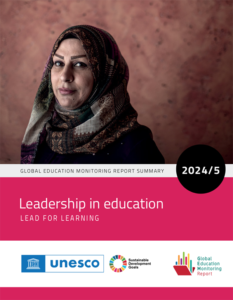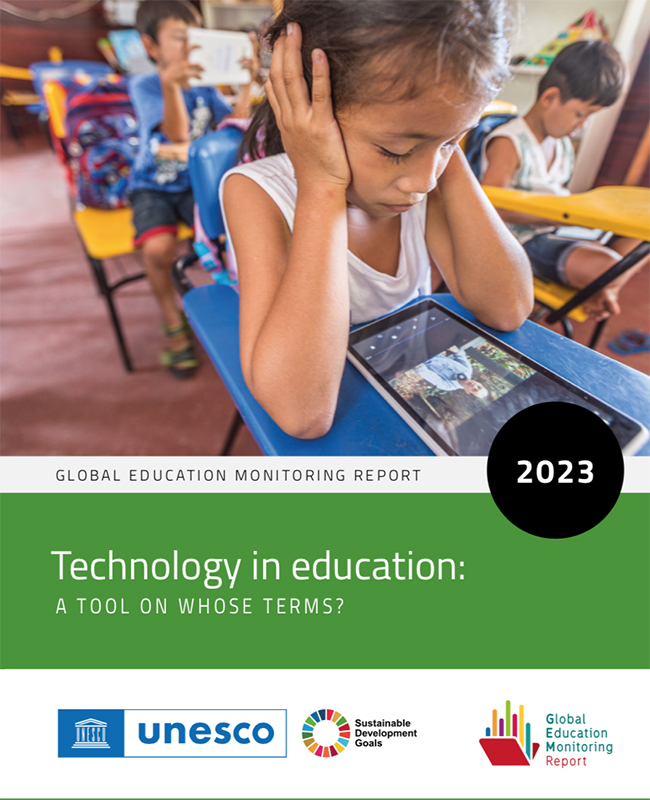Much has been said about the influence of teachers on their students’ learning outcomes. However, the role of school leaders and their undeniable impact on education quality, though well-supported by evidence, often remains in the background despite its significance. Acknowledging this, UNESCO has dedicated its latest GEM report to addressing this critical issue.
Beyond Management: Leadership as a Driver of Transformation
What comes to mind when we think of a school leader? Most likely, we picture a principal overseeing the daily operations of a school: assigning schedules, managing budgets, resolving administrative issues, or making disciplinary decisions. While this image is partly accurate, it does not capture the depth and complexity of educational leadership.
Educational leadership goes far beyond operational or administrative management of a school. It is not merely about ensuring resources are available or daily tasks are accomplished, though these functions are important. At its core, educational leadership involves transformative capabilities: a process in which leaders not only organize but also inspire, mobilize, and empower members of the educational community, from teachers and students to families and support staff.
It is a dynamic process of social influence that drives teams, school communities, and systems toward shared goals. Educational leaders set clear visions, promote pedagogical innovations, foster inclusive environments, and strategically manage resources. In this sense, they are key to overcoming educational inequalities and addressing global challenges such as the impact of digitalization, the effects of the pandemic, and adaptation to climate change.
The impact of educational leadership is evident: according to the report, schools with effective leaders tend to show better academic results, greater social cohesion, and higher levels of inclusion. But what underpins good educational leadership? What challenges do leaders face? What strategies can be used to strengthen it? These questions are explored below.
Educational leadership involves transformative capabilities: a process in which leaders not only organize but also inspire, mobilize, and empower members of the educational community.
What Defines Effective Educational Leadership?
According to the GEM Report 2024/5, effective educational leadership focuses on four key areas that guide leaders’ actions at all levels:
- Setting Clear Expectations: Educational leaders must define an inspiring vision that motivates their school communities. This involves setting ambitious goals for students and teachers based on equity and quality learning.
- Focusing on Learning: Leadership should aim to improve pedagogical practices. This includes supervising teaching, coordinating curricula, and ensuring resources align with educational objectives.
- Fostering Collaboration: Schools perform better when leadership is shared. Promoting collaboration among teachers, students, and families reinforces collective commitment and creates a more inclusive, resilient environment.
- Developing People’s Potential: Supporting the professional growth of teachers and other school community members is essential. This not only enhances teaching quality but also strengthens the sense of belonging and motivation.
These dimensions apply not only to school principals but also to systemic and policy-level leaders, who must align their actions with these priorities to achieve sustainable impact.
Challenges Faced by Educational Leaders
Despite their importance, educational leaders face numerous obstacles that limit their effectiveness. Key challenges include:
Lack of Preparation and Professionalization
In many countries, educational leaders assume their roles without adequate training to address the challenges of leading a school or managing an educational system. According to the report, only 30% of school principals have received specific training before taking office. Additionally, fewer than 20% of leadership training programs address the four key dimensions mentioned above. As a result, leaders often exercise reactive leadership, lacking strategic planning and focusing on administrative tasks.
Inequitable Selection Processes
The way educational leaders are selected is also problematic. Only 63% of countries implement open and competitive processes for selecting principals. In many cases, political favoritism or arbitrary decisions affect the quality of appointments. Furthermore, a lack of diversity is notable: although most teachers are women, they are underrepresented in leadership roles (the proportion of women in leadership positions is at least 20 percentage points lower than their representation in teaching). Selection processes also tend to exclude candidates from ethnic, linguistic, or socioeconomic minorities.
Excessive Demands and Lack of Time
School principals face administrative burdens that leave little time for effective pedagogical leadership. On average, they spend 68% of their time on administrative tasks, such as budget management or operational problem-solving. This administrative overload distances them from key functions such as supervising learning, supporting teachers, or implementing long-term strategies, leading to stress and demotivation.
Lack of Support for System Leaders
Educational officials operating at regional or national levels often lack the technical preparation and autonomy needed to implement meaningful reforms. In countries like Ethiopia and Guinea, fewer than 12% of these leaders have training in educational planning and management.
Strategies to Strengthen Educational Leadership
The GEM Report 2024/5 proposes several key strategies to enhance the impact of educational leadership. These recommendations can guide policymakers and educational organizations:
Granting Autonomy and Resources
Autonomy is essential for educational leaders to make decisions relevant to their school communities’ specific needs. This includes managing human resources, such as hiring and retaining teachers, allocating budgets based on local priorities, and designing pedagogical strategies tailored to their contexts. However, autonomy must be complemented by sufficient resources. Without necessary funding or logistical support, autonomy can become a burden. Clear accountability mechanisms are also essential to ensure transparent and effective resource use, strengthening trust among school leaders, communities, and educational authorities.
Professionalizing Educational Leadership
Professionalization begins with inclusive, fair, and competency-based selection processes. This requires moving away from favoritism or political appointments and establishing objective criteria that evaluate key skills, such as pedagogical leadership, management ability, and strategic vision. Training programs should address the four fundamental dimensions: setting expectations, focusing on learning, fostering collaboration, and developing people. Mentorship programs, where experienced leaders support newcomers, and continuous professional development opportunities are also crucial for adapting to changes and challenges in the educational system.
Promoting Shared Leadership
Shared leadership recognizes that a school or educational system’s success does not depend solely on a central figure but on the active collaboration of all stakeholders: teachers taking on pedagogical leadership roles in the classroom, students participating in decision-making, and parents contributing to school community development. Promoting this type of leadership involves creating formal structures, such as school councils, that integrate these groups into planning and decision-making processes.
Empowering Public Administration Leaders
Regional and national educational leaders, such as supervisors, planners, and ministers, need technical and strategic skills to implement effective policies. Training in data analysis to identify and address educational inequalities, resource management for equitable budgeting, and pedagogical supervision to ensure teaching quality are essential. These leaders also need support in leadership skills, such as strategic communication and coalition-building, to navigate complex environments and promote sustainable change.
Strengthening Educational Leadership to Improve Education
From classrooms to ministries, school leaders can make a difference by ensuring that all students, regardless of their background, have access to quality education. However, this requires recognizing their importance and equipping them with resources, autonomy, and training.
Today’s society faces complex educational challenges that demand strong leadership capable of inspiring change. Behind every effective educational leader are countless students with better learning and development opportunities. Let’s make it possible.







